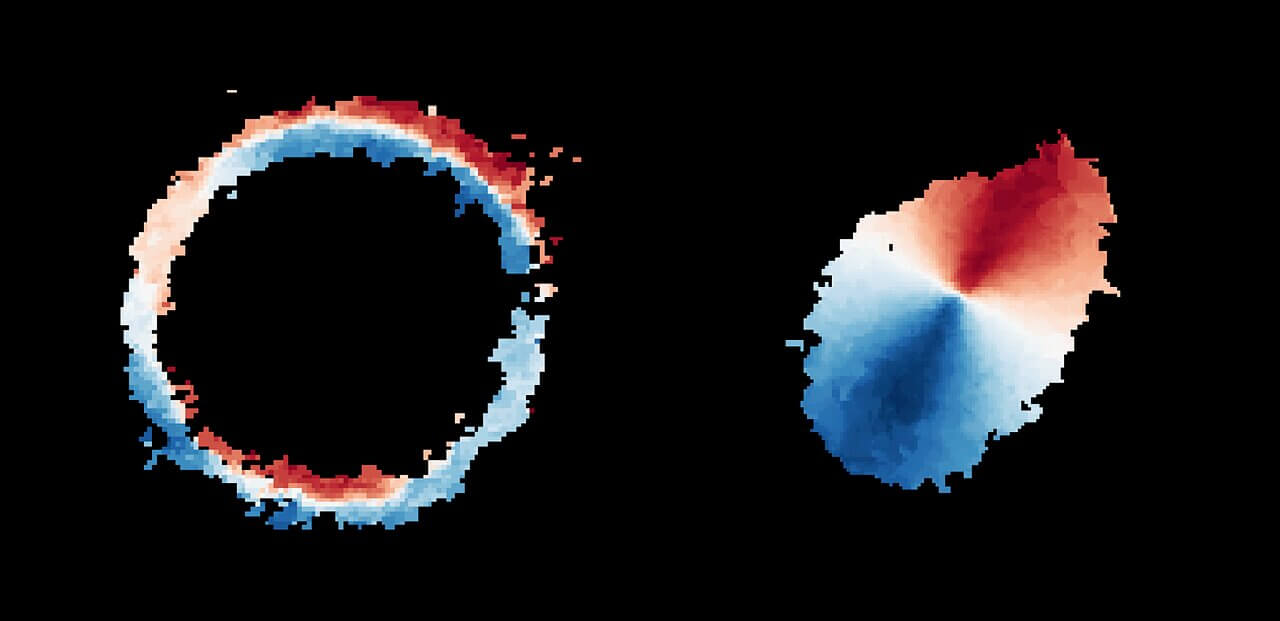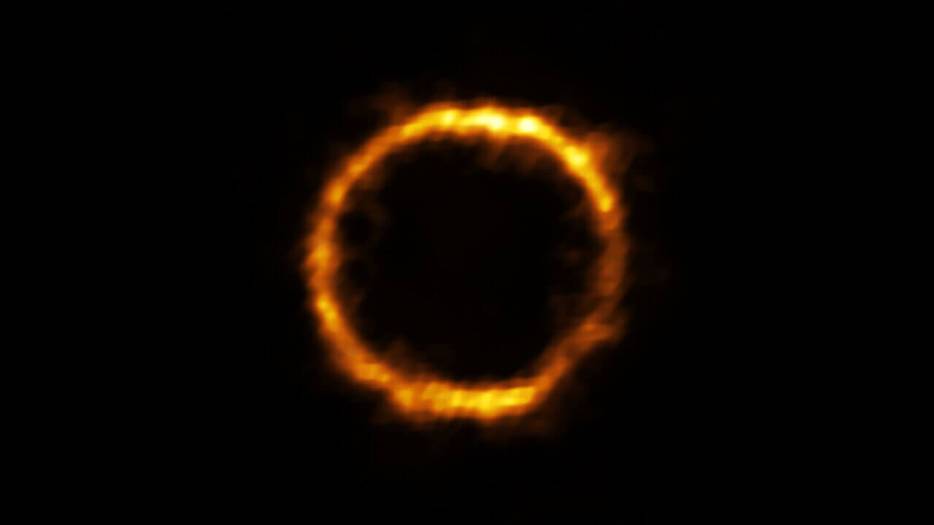Lensed view of SPT0418-47. Image © ALMA (ESO/NAOJ/NRAO), Rizzo et al. Lately, SPT0418–47 was observed with ALMA on 5 July 2017 under project code 2016.1.01499.S.
Astronomers from Max-Planck Institute for Astrophysics, Garching, Germany, Kapteyn Astronomical Institute, ASTRON in partner with European Southern Observatory (ESO) using Atacama Large Millimeter/submillimeter Array (ALMA) have revealed an extremely distant and therefore very young galaxy that looks similar to our Milky Way galaxy. They reported the presence of a dynamically cold galaxy, named SPT–S J041839–4751.9 (later named SPT0418–47), which lies so far that its light has taken more than 12 billion years to reach us and this contradicts our theories and understanding that all galaxies in the early universe were turbulent and unstable. This unexpected discovery challenges our understanding of how galaxies form, giving new insights into the past of our universe.
Francesca Rizzo, the PhD student from the Max Planck Institute for Astrophysics in Germany, who led the research published today in Nature, said; “This result represents a breakthrough in the field of galaxy formation, showing that the structures that we observe in nearby spiral galaxies and in our Milky Way were already in place 12 billion years ago.”
While the team observes the galaxy SPT0418–47 using the Atacama Large Millimeter/submillimetre Array (ALMA), they didn’t saw any spiral arms but saw a rotating disc and a bulge. They found the rotation curve of SPT0418–47 with the typical shape of a bulge-dominated spiral galaxy in the local universe. The galaxy has a bump at 0.2 kpc from the galaxy centre and then declines before flattening at radii greater than 1.5 kpc.
Team detected a large group of stars packed tightly around the galactic centre which make this observation the first observation on which a bulge has been seen this early in the history of the universe and make SPT0418-47 the most distant Milky Way look-alike.
SPT0418–47 has total stellar mass (Mstar) equal to 1.2 (+0.2/-0.1) × 1010 M☉, dark-matter mass MDM equal to 1.7 (+0.3/-0.3) × 1012 M☉, gas/fraction (𝒇gas) = 0.53(+0.06/−0.08) and stellar effective radius (Re) = 0.22 (+0.04/-0.02) kpc.
[1 Solar mass (M☉) ~ 2 × 1030 kg, 1 kpc ~ 3261 light-year, 1 light-year ~ 9 ✕ 1012 kilometer].
Have you noticed that the light from galaxy SPT0418–47 took more than 12 billion years to reach us and what does this means? This signifies that we see it as it was when the universe was just 1.4 billion years old. This is the fascination of astronomical technique and observation.
Co-author, Filippo Fraternali, from the Kapteyn Astronomical Institute, the University of Groningen, Netherlands said, “The big surprise was to find that this galaxy is actually quite similar to nearby galaxies, contrary to all expectations from the models and previous, less detailed, observations.” In the early universe, young galaxies were still in the process of forming, so researchers expected them to be chaotic and lacking the distinct structures typical of more mature galaxies like the Milky Way.
The galaxy SPT0418–47 lies so far away from us that the detailed observation even by the most powerful telescopes we currently have is not possible. So, the team exploited the advantages of the gravitational lensing technique and used a nearby galaxy as a powerful magnifying glass which allowed ALMA to see into the distant past in unprecedented detail.
In this effect, the gravitational pull from the nearby galaxy distorts and bends the light from the distant galaxy, causing it to appear misshapen and magnified.
Here, the gravitationally lensed, distant galaxy appears as a near-perfect ring of light around the nearby galaxy. Analysing the data from ALMA Archive by using a new computer modelling technique, called Common Astronomy Software Applications (CASA) package, here the research team were able to reconstruct the distant galaxy’s true shape and the motion of its gas.

Rizzo said, “When I first saw the reconstructed image of SPT0418-47 I could not believe it: a treasure chest was opening.”
“What we found was quite puzzling; despite forming stars at a high rate, and therefore being the site of highly energetic processes, SPT0418-47 is the most well-ordered galaxy disc ever observed in the early universe,” stated co-author Simona Vegetti, also from the Max Planck Institute for Astrophysics. “This result is quite unexpected and has important implications for how we think galaxies evolve."
Though SPT0418-47 has a disc and other features similar to those of spiral galaxies we see today, astronomers expect it to evolve into a galaxy very different from the Milky Way, and join the class of elliptical galaxies, another type of galaxies that inhabit the universe today.
The findings suggest that the early universe may not be as chaotic as once believed and also raise questions on how a well-ordered galaxy could have formed so soon after the Big Bang. This unexpected discovery also underpins the earlier discovery of a massive rotating disk in the early universe of the same ALMA observatory.
SPT0418-47 is seen in finer detail, thanks to the lensing effect, and has a bulge in addition to a disc, making it even more similar to our present-day Milky Way than the one studied previously.
Future studies, including with ESO’s Extremely Large Telescope, will seek to uncover how typical these ‘baby’ disc galaxies really are and whether they are commonly less chaotic than predicted, opening up new avenues for astronomers to discover how galaxies evolved.
